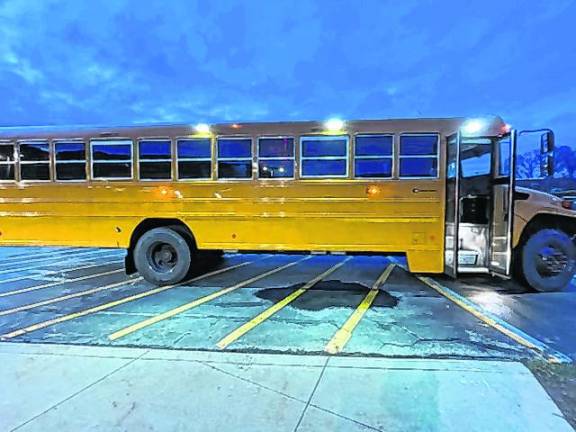Electric bus conversion may come with eight-figure price tag
Warwick. The WV BOE heard a rundown of the cost estimates and infrastructure needs for the electric bus mandate at its April 4 meeting.

The Warwick Valley Central School District Board of Education offered a deep dive into all things transportation — especially electric school buses — at its April 4 work session.
As it works to meet Governor Kathy Hochul’s mandate requiring all new bus purchases be electric beginning in 2027, completing the changeover to an all-electric fleet by 2035, the district is conducting a study to determine the necessary steps and timing to transition its gas, diesel, and propane-powered fleet to electric. The administration is investigating the logistics, including build-out of charging stations, safety issues, and implementation.
The District will evaluate its existing fleet and work with Orange & Rockland to analyze current electrical capabilities to help identify what actions need to be taken, and the estimated cost, to electrify their fleet.
The resulting information will enable the administration to identify capital project work, plan which vehicles it will replace, and set a phased plan to install the battery chargers.
Bus fleet by the numbers
Warwick Valley currently has a fleet of 76 buses: 54 65-passenger, five 20-30 passenger, eight 20-30 passenger, six wheelchair-accessible buses, and three nine-passenger.
Diesel makes up the greatest share of those, with 28 buses, plus 26 gasoline-powered buses, and 22 propane buses. Currently, the cost of diesel, gas, and propane costs the district between $250,000 and $275,000.
Replacement costs
The District is considering a phased-in approached, adding several electric buses over the course of three years. For the district to buy five electric bus replacements for the 2026-27 school year, it would cost an average of $2,000,000, less the nearly 65% in projected transportation aid ($1,298,000), making the net cost $702,000. The following year, they could replace eight buses for a net cost of $1,123,200.
Assuming the district replaces nine buses a year every year thereafter (concluding in 2035, to meet the governor’s mandate), the total average projected replacement cost would be $29,050,000, with a net cost of $10,196,550. The caveat is that these costs don’t include incentives, rebates, or grants outside of the state aid noted.
Route analysis
There are nearly 60 routes spanning over 2,000 miles; once the fleet is converted to electric, 40 of those buses would be good to go on one charge; 11 would be “borderline;” and seven would require an additional charge.
Infrastructure
For battery charging, the district could opt for an AC connection that recharges in 5.5 to 13 hours for $400 to up to $6,500, or a DC connection with a charging time of one to 4.5 hours, at a range of $10,000 to $40,000.
Estimated cost of the equipment is between $800,000 and $1,000,000; however, infrastructure costs are subsidized mainly through Transportation Aid, according to Assistant Superintendent for Business Timothy Holmes. The district also may apply for various state grants.
According to Jeremy Johnston, director of sales for New York Bus Sales, the school district would qualify for $100,000 in NYSERDA grants. He recommended scrapping a certain amount of traditional buses to get credit and/or the grant.
Jack Eisenbach, Warwick Valley’s engineer, said that state aid will be $55,000 per charger per bus. He pointed out that Warwick would have to go with the DC option, as AC is too slow. “It just won’t work (for our purposes).”
O&R also reportedly told the district they would upgrade the utility as the school district needs it, potentially on a per year basis as the rollout takes place.
Anticipating the switch
Johnston also gave the board a rundown of electric bus basics, including how to use the battery chargers and heating the buses properly in the morning before the first run of the day.
“Training is critical,” he said.
School Superintendent, Dr. David Leach, asked about fire emergencies, in light of last year’s battery fire.
“It’s no different than diesel buses,” Johnston maintained. “One [district] had a diesel fire in their garage and lost their whole fleet.”
School board member Bill Fanos challenged that assertion, because of different fire suppression requirements for electrical versus diesel fires.
Some members of the board wondered about long-term cost-savings: “You’ll definitely go through tires more quickly,” Leach said, but added, “[you’ll] save on oil changes,” and other fluid changes that are required in traditional engines but not in electric motors.
Fanos questioned the lifespan of the electric batteries. Johnston said the batteries are warranted for eight years or 125,000 miles, depending upon charging frequency.
Fanos also raised concerns about disposal of spent batteries and whether there are hazmat fees involved. “Most of those components are recyclable,” added Johnston.
Board member Bob Howe asked about the potential for increased electricity costs. Holmes replied that electric buses will cost more in electricity, due to greater demand, which could lead to higher prices/costs.
“Can we rely on the solar field to offset some of these costs?” Howe asked.
“When we installed the Sanfordville solar field,” Eisenbach said, “all that power’s sold to O&R – then we buy power back from them...Not sure if O&R will want to sell us more power directly.” He added, “O&R is buying a lot of power back” from the 10-acre solar fields.
“We’re covering about 75% of our electricity costs [about $400,000 to $500,000],” Holmes said.
Addressing Johnston, Eisenbach asked, “What is a realistic delivery [date] for a bus?”
“If we order now,” Johnston replied, “we could deliver by January 1.”
Leach hastened to add, “Of course, we wouldn’t order buses without voter approval.”